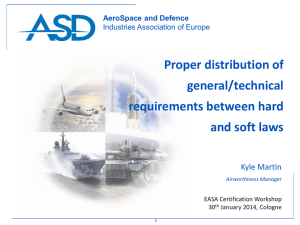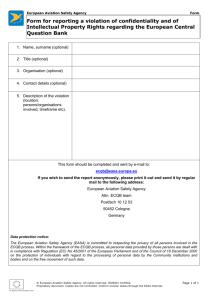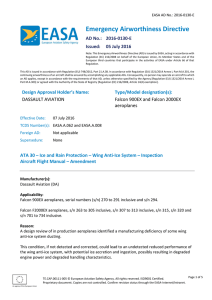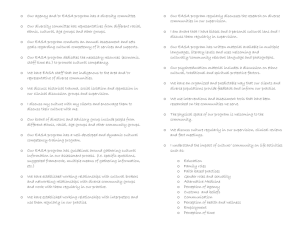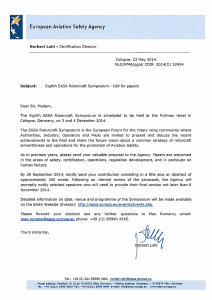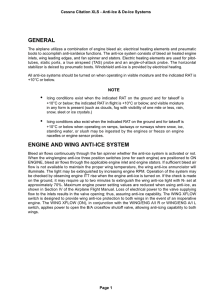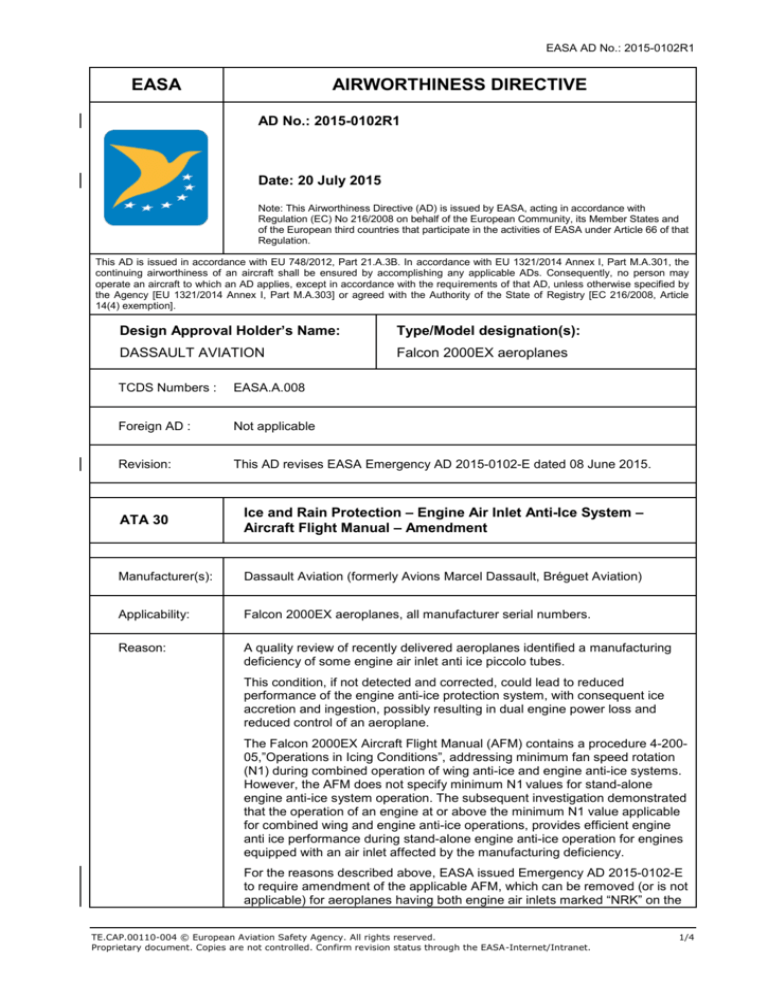
EASA AD No.: 2015-0102R1
EASA
AIRWORTHINESS DIRECTIVE
AD No.: 2015-0102R1
Date: 20 July 2015
Note: This Airworthiness Directive (AD) is issued by EASA, acting in accordance with
Regulation (EC) No 216/2008 on behalf of the European Community, its Member States and
of the European third countries that participate in the activities of EASA under Article 66 of that
Regulation.
This AD is issued in accordance with EU 748/2012, Part 21.A.3B. In accordance with EU 1321/2014 Annex I, Part M.A.301, the
continuing airworthiness of an aircraft shall be ensured by accomplishing any applicable ADs. Consequently, no person may
operate an aircraft to which an AD applies, except in accordance with the requirements of that AD, unless otherwise specified by
the Agency [EU 1321/2014 Annex I, Part M.A.303] or agreed with the Authority of the State of Registry [EC 216/2008, Article
14(4) exemption].
Design Approval Holder’s Name:
Type/Model designation(s):
DASSAULT AVIATION
Falcon 2000EX aeroplanes
TCDS Numbers :
EASA.A.008
Foreign AD :
Not applicable
Revision:
This AD revises EASA Emergency AD 2015-0102-E dated 08 June 2015.
ATA 30
Ice and Rain Protection – Engine Air Inlet Anti-Ice System –
Aircraft Flight Manual – Amendment
Manufacturer(s):
Dassault Aviation (formerly Avions Marcel Dassault, Bréguet Aviation)
Applicability:
Falcon 2000EX aeroplanes, all manufacturer serial numbers.
Reason:
A quality review of recently delivered aeroplanes identified a manufacturing
deficiency of some engine air inlet anti ice piccolo tubes.
This condition, if not detected and corrected, could lead to reduced
performance of the engine anti-ice protection system, with consequent ice
accretion and ingestion, possibly resulting in dual engine power loss and
reduced control of an aeroplane.
The Falcon 2000EX Aircraft Flight Manual (AFM) contains a procedure 4-20005,”Operations in Icing Conditions”, addressing minimum fan speed rotation
(N1) during combined operation of wing anti-ice and engine anti-ice systems.
However, the AFM does not specify minimum N1 values for stand-alone
engine anti-ice system operation. The subsequent investigation demonstrated
that the operation of an engine at or above the minimum N1 value applicable
for combined wing and engine anti-ice operations, provides efficient engine
anti ice performance during stand-alone engine anti-ice operation for engines
equipped with an air inlet affected by the manufacturing deficiency.
For the reasons described above, EASA issued Emergency AD 2015-0102-E
to require amendment of the applicable AFM, which can be removed (or is not
applicable) for aeroplanes having both engine air inlets marked “NRK” on the
TE.CAP.00110-004 © European Aviation Safety Agency. All rights reserved.
Proprietary document. Copies are not controlled. Confirm revision status through the EASA-Internet/Intranet.
1/4
EASA AD No.: 2015-0102R1
associated data plate.
Since that AD was issued, it was identified that this requirement only applies
to aeroplanes equipped with engine air inlet Part Number (P/N) 06ND71600-1
and that some clarification was needed related to engine air inlets that have
been refurbished by NORDAM.
This AD is still considered to be an interim measure and further AD action
may follow.
Effective Date:
Revision 1: 27 July 2015
Original issue: 10 June 2015
Required
Action(s) and
Compliance
Time(s):
Required as indicated, unless accomplished previously:
For aeroplanes equipped with engine air inlet P/N 06ND71600-1:
(1) Within 10 flight cycles after 10 June 2015 [the effective date of this AD at
original issue], amend the applicable AFM as specified in Appendix 1 of
this AD, inform the flight crew and, thereafter, operate the aeroplane
accordingly.
Amending the AFM can be accomplished by inserting a copy of
Appendix 1 of this AD into the applicable AFM.
(2) An aeroplane which incorporates, on both engines, an air inlet P/N
06ND71600-1 with a marking “NTR-RKFAL97” or “NTR-RKFAL98” (see
Note below) on the data plate is not (or no longer, as applicable) affected
by the requirement of paragraph (1) of this AD.
Note: Engine air inlets P/N 06ND71600-1 which were already refurbished
(NORDAM Rework Kit applied) comply with the design standard and are
marked as “NTR-RKFAL97” or “NTR-RKFAL98” on the air inlet data plate.
Examples of data plates are shown in Appendix 2 of this AD.
Ref.
Publications:
Remarks :
None
1. If requested and appropriately substantiated, EASA can approve
Alternative Methods of Compliance for this AD.
2. Based on the required actions and the compliance time, EASA have
decided to issue a Final AD with Request for Comments, postponing the
public consultation process until after publication.
3. Enquiries regarding this AD should be referred to the Safety Information
Section, Certification Directorate, EASA. E-mail: ADs@easa.europa.eu.
4. For any question concerning the technical content of the requirements in
this AD, please contact your Dassault Falcon Technical Assistance:
For Europe, Middle East and Africa based operators:
Hot Line: (33) 1 47 11 37 37
For USA, Canada and Mexico based operators:
Help Desk: (1) 800-2FALCON (2325266)
All other areas:
Help Desk: (1) 201 541 4747
TE.CAP.00110-004 © European Aviation Safety Agency. All rights reserved.
Proprietary document. Copies are not controlled. Confirm revision status through the EASA-Internet/Intranet.
2/4
EASA AD No.: 2015-0102R1
Appendix 1
Amendment to AFM sections 4-200-05, 4-200-05A OPERATION IN ICING CONDITIONS
This amendment comes in additions to existing AFM procedures
Engine Anti Ice System Operation
During in flight operation of an engine anti-ice system (ENG ANTI-ICE) maintain the N1 of both engines
equal to or more then the values defined in Table 1 of this Appendix, as applicable to atmospheric
condition.
Table 1
Minimum N1 values required during in flight operation of an engine anti-ice system
TAT – Total Air Temperature
Z - Altitude
Note 1: Maintaining the N1 above the minimum anti-ice N1 on both engines may lead to exceedance of
approach speed. Early approach or landing configuration of an aeroplane and/or application of airbrakes
may be used to control the excessive airspeed. If, the airspeed remains higher than required, it is
authorized to reduce the thrust by reducing the N1 below to values indicated in the Table 1 of this
Appendix for the last 3 minutes before touchdown. In this case disengage Autothrottle, if previously
engaged. This 3 minutes operation below the minimum N1 does not apply to any other in-flight icing
situation.
Note 2: During ground operations before take-off, the engine anti ice system remains efficient when
engine power levers are at idle.
TE.CAP.00110-004 © European Aviation Safety Agency. All rights reserved.
Proprietary document. Copies are not controlled. Confirm revision status through the EASA-Internet/Intranet.
3/4
EASA AD No.: 2015-0102R1
Appendix 2
Example of air inlet data plate marked with NORDAM Rework Kit (NRK)
NRK : NTR-RKFAL97
NRK : NTR-RKFAL98
TE.CAP.00110-004 © European Aviation Safety Agency. All rights reserved.
Proprietary document. Copies are not controlled. Confirm revision status through the EASA-Internet/Intranet.
4/4

